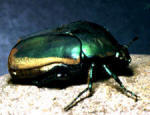 Seraphim fly is a generic name given to an entire group of flies.
There are some differences in appearance and color, but the
yellow and black color is the major one in our area. The other
names for syrphid flies are hover flies or flower flies. They
tend to hover around your arms and face when you have been
perspiring and land to lap up the sweat. They are also commonly
found on flowers, hence the flower fly name, and do a good job
of pollinating. Seraphim fly is a generic name given to an entire group of flies.
There are some differences in appearance and color, but the
yellow and black color is the major one in our area. The other
names for syrphid flies are hover flies or flower flies. They
tend to hover around your arms and face when you have been
perspiring and land to lap up the sweat. They are also commonly
found on flowers, hence the flower fly name, and do a good job
of pollinating.Syrphid flies are actually beneficial insects.
They help pollinate, larvae feed on dead organic matter, and the
larvae are predators of aphids. Syrphid flies cannot sting, but
their mouthparts can usually be felt when lapping up sweat from
sensitive areas. You may feel a slight pinch. No controls are
going to be very effective. On the other hand, there really
isn't much need for control. They are really a nuisance pest.
They are very agile and will probably be able to avoid that
aerosol spray. Inside the home, a swatter and a vacuum cleaner
are probably the best tools.
An insect similar in appearance to the Japanese beetle has
made its annual appearance. That insect is the green June bug.
These beetles are much larger than either June bugs or Japanese
beetles. Most people are concerned that they have bumble bees
because of the buzzing sound the beetles make when flying, or
they have the "supersized" Japanese beetle.
 Green June bugs are also called fig eaters. This is because
they can eat soft-fleshed fruits such as grapes, plums, peaches
and apricots. In their larval stage they are a grub, but they
don't do a lot of turf damage like the normal June bug. They
tend to be in places high in organic matter, such as flower
beds, gardens, compost piles and under shrubs. Green June bugs are also called fig eaters. This is because
they can eat soft-fleshed fruits such as grapes, plums, peaches
and apricots. In their larval stage they are a grub, but they
don't do a lot of turf damage like the normal June bug. They
tend to be in places high in organic matter, such as flower
beds, gardens, compost piles and under shrubs.
As for control, there is probably none necessary unless you
need to protect those soft-fleshed fruits. Then you should
follow the recommended spray program so you don't cause problems
with the fruit later on. The green June bug doesn't sting or
bite, so you can put them in the nuisance pest category. The
main damage they can do is fly into you.
[to top of second column]
 |

 The cicada killer wasps have returned! They are actually
considered beneficial insects because they control cicadas. This
wasp gets its common name due to the fact that it hunts and supplies
its nest chambers with a cicada, which becomes a food source for the
young cicada killer. Cicada killers are a nuisance pest, especially
when nesting in large numbers in a play area or near the house.
People get concerned because the cicada killers resemble giant-sized
yellow jackets. The cicada killer wasps have returned! They are actually
considered beneficial insects because they control cicadas. This
wasp gets its common name due to the fact that it hunts and supplies
its nest chambers with a cicada, which becomes a food source for the
young cicada killer. Cicada killers are a nuisance pest, especially
when nesting in large numbers in a play area or near the house.
People get concerned because the cicada killers resemble giant-sized
yellow jackets.
Cicada killers are about 2 inches long and black to red, with
yellow-banded markings on the abdomen. The head and transparent
wings are reddish brown. They are not dangerous, but they are
intimidating. Cicada killers are solitary wasps, with the female
digging a 6- to 10-inch burrow (1/2 inch in diameter) in the ground.
A pile of soil typically surrounds the entrance.
Cicada killers are unlikely to sting a person. Wasp and bee
stingers are modified egg-laying devices (ovipositors), so males are
not able to sting. Females may sting if crushed, either by being
stepped on with bare feet or grabbed with bare hands.
Applying permethrin or Sevin (some suggest the Sevin dust gives
better control) to the burrowed area should kill females in
high-traffic areas. In home yards, sandboxes can be covered with a
tarp when not in use, as this deters the wasps (and also keep cats
out). Sand below swings, jungle gyms or other playground equipment
is a popular site for the cicada killer. Raking the sand may
discourage the wasps, or you could use mulch instead of the sand.
[John
Fulton, unit leader,
University of Illinois Extension,
Logan County Unit]
 |